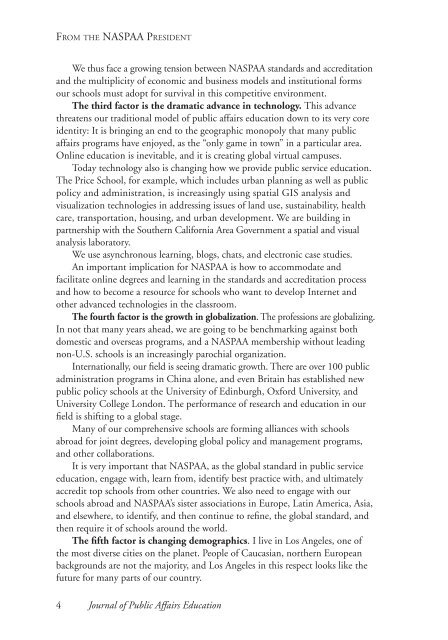Download - National Association of Schools of Public Affairs and ...
Download - National Association of Schools of Public Affairs and ...
Download - National Association of Schools of Public Affairs and ...
Create successful ePaper yourself
Turn your PDF publications into a flip-book with our unique Google optimized e-Paper software.
From the NASPAA President<br />
We thus face a growing tension between NASPAA st<strong>and</strong>ards <strong>and</strong> accreditation<br />
<strong>and</strong> the multiplicity <strong>of</strong> economic <strong>and</strong> business models <strong>and</strong> institutional forms<br />
our schools must adopt for survival in this competitive environment.<br />
The third factor is the dramatic advance in technology. This advance<br />
threatens our traditional model <strong>of</strong> public affairs education down to its very core<br />
identity: It is bringing an end to the geographic monopoly that many public<br />
affairs programs have enjoyed, as the “only game in town” in a particular area.<br />
Online education is inevitable, <strong>and</strong> it is creating global virtual campuses.<br />
Today technology also is changing how we provide public service education.<br />
The Price School, for example, which includes urban planning as well as public<br />
policy <strong>and</strong> administration, is increasingly using spatial GIS analysis <strong>and</strong><br />
visualization technologies in addressing issues <strong>of</strong> l<strong>and</strong> use, sustainability, health<br />
care, transportation, housing, <strong>and</strong> urban development. We are building in<br />
partnership with the Southern California Area Government a spatial <strong>and</strong> visual<br />
analysis laboratory.<br />
We use asynchronous learning, blogs, chats, <strong>and</strong> electronic case studies.<br />
An important implication for NASPAA is how to accommodate <strong>and</strong><br />
facilitate online degrees <strong>and</strong> learning in the st<strong>and</strong>ards <strong>and</strong> accreditation process<br />
<strong>and</strong> how to become a resource for schools who want to develop Internet <strong>and</strong><br />
other advanced technologies in the classroom.<br />
The fourth factor is the growth in globalization. The pr<strong>of</strong>essions are globalizing.<br />
In not that many years ahead, we are going to be benchmarking against both<br />
domestic <strong>and</strong> overseas programs, <strong>and</strong> a NASPAA membership without leading<br />
non-U.S. schools is an increasingly parochial organization.<br />
Internationally, our field is seeing dramatic growth. There are over 100 public<br />
administration programs in China alone, <strong>and</strong> even Britain has established new<br />
public policy schools at the University <strong>of</strong> Edinburgh, Oxford University, <strong>and</strong><br />
University College London. The performance <strong>of</strong> research <strong>and</strong> education in our<br />
field is shifting to a global stage.<br />
Many <strong>of</strong> our comprehensive schools are forming alliances with schools<br />
abroad for joint degrees, developing global policy <strong>and</strong> management programs,<br />
<strong>and</strong> other collaborations.<br />
It is very important that NASPAA, as the global st<strong>and</strong>ard in public service<br />
education, engage with, learn from, identify best practice with, <strong>and</strong> ultimately<br />
accredit top schools from other countries. We also need to engage with our<br />
schools abroad <strong>and</strong> NASPAA’s sister associations in Europe, Latin America, Asia,<br />
<strong>and</strong> elsewhere, to identify, <strong>and</strong> then continue to refine, the global st<strong>and</strong>ard, <strong>and</strong><br />
then require it <strong>of</strong> schools around the world.<br />
The fifth factor is changing demographics. I live in Los Angeles, one <strong>of</strong><br />
the most diverse cities on the planet. People <strong>of</strong> Caucasian, northern European<br />
backgrounds are not the majority, <strong>and</strong> Los Angeles in this respect looks like the<br />
future for many parts <strong>of</strong> our country.<br />
4 Journal <strong>of</strong> <strong>Public</strong> <strong>Affairs</strong> Education

















